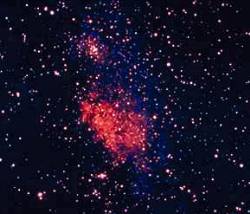11 June 1998
Universe's Brightest Object Dazzles The Imagination
 Between 4 million-billion and 5 million-billion times more intense than our Sun, the brightest known object in the Universe is a quasar some 11 billion light years from Earth. Outshining the brightest galaxy by more than 100 times, the dazzling cosmic super-bulb could help scientists understand more about the origins and structure of the Universe. It will also go down in the record books as one of the sexiest astronomical discoveries of the decade.
Between 4 million-billion and 5 million-billion times more intense than our Sun, the brightest known object in the Universe is a quasar some 11 billion light years from Earth. Outshining the brightest galaxy by more than 100 times, the dazzling cosmic super-bulb could help scientists understand more about the origins and structure of the Universe. It will also go down in the record books as one of the sexiest astronomical discoveries of the decade.
"'Sexiest' is not a phrase often attached to scientific discovery," astronomer Geraint Lewis of Washington University confides, "but I would have to say that this is one of the most exciting things I have had to work on so far in my career."
Lewis and his collaborators stumbled across the quasar by accident while studying the break up of the Sagittarius dwarf galaxy (pictured), our tiny neighbour currently being torn apart by the more massive Milky Way. Suddenly, they came across something that looked deceptively like a nearby star, but was in fact billions of light years off.
"Basically then, you have an object that looks like a star in our galaxy, but is really many times further away, and therefore must be very bright," explains Lewis. "We worked out the numbers and it turns out that this galaxy releases around 5 million-billion times more energy than the Sun."
The finding, reported in the current issue of Nature, has caused a stir of excitement in astronomical circles, and the quasar has been scheduled for observation by the heavy-duty Hubble Space Telescope in the near future. Of particular interest is how the object's incredible brightness actually comes from two distinct sources. Light in the optical range is generated from friction as matter is violently torn apart by the gravity of a super-massive black hole lurking at the quasar's centre. Infrared light also results from thick dust heated by radiation.
"Quasars can be thought of as hyperactive galaxies," explains Lewis. "These are galaxies, possibly a little like our own, but at the very centre lurk a super-massive black hole, more than a million times heavier than the Sun. Material falls toward the hole and begins to orbit in a disk known as an accretion disk. Friction between the material heats the disk up and causes it to glow extremely brightly. The energy put out by such a disk normally exceeds all the energy from all the ten billion or so stars in a galaxy. This disk, however, is astronomically very small, being not much bigger than the size of the solar system."
